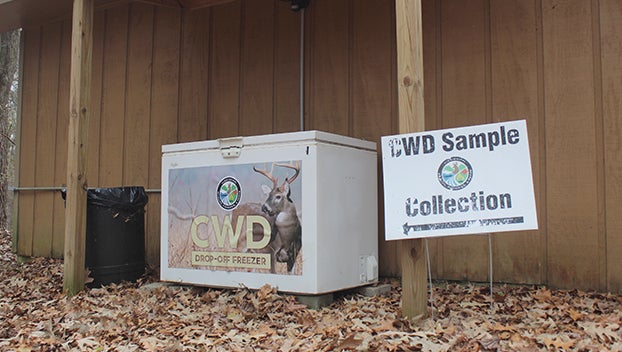Commission relaxes deer disease management zones despite human health risk
Published 2:47 pm Monday, June 26, 2023

- Chronic Wasting Disease samples can be dropped off at Natchez State Park. You can take antlers as long as you leave the skull plate and neck with lymph nodes attached at the drop off cooler. Hunters fill out a sample card at the station with their name, contact information and where the deer was harvested. CWD samples are needed across Mississippi to find new areas of the disease to better contain the disease. (Hunter Cloud | The Natchez Democrat)
|
Getting your Trinity Audio player ready...
|
QUITMAN — Mississippi Department of Wildlife, Fisheries and Parks Commissioners voted to relax CWD zones Thursday. They made the changes without input from the MDWFP’s biologists or the general public as they have the power to do so.
Mississippi’s most recent detection of Chronic Wasting Disease, an always fatal disease in deer, was in a new area in December 2022. A hunter harvested a doe on a club in Tunica County in the Southeastern corner in close proximity to Coahoma and Quitman counties.
Under the MDWFP CWD management plan, counties within 10 miles of the positive should have gone into a management zone.
Commissioners voted to define new CWD zones from a 10 mile radius from the most recent positive in a county to a boundary at the 10 mile radius such as a highway or river. Louisiana has used a similar approach in defining CWD zones but often has a buffer zone included in their radius giving them a wider CWD zone.
Gary Rhoads, MDWFP Commissioner, said it did not make any sense to ban supplemental feeding in an entire county if people were 50 miles away from the positive. Commissioners voted in November 2022 to rescind a supplemental feed ban in Claiborne County after a man ticketed for knowingly feeding deer illegally and an outdoor store owner from Vicksburg pleaded for the commission to overturn the feed ban.
Supplemental feeding through feeders is not necessary for healthy deer despite popular belief. MSU Deer Lab has done a lot of research demonstrating the positive effects food plots, forb and browse production through habitat management have on deer size and health. CWD zones ban feeding because the unnatural congregation of deer around feeders could cause the disease to spread.
Pleas from Claiborne County resident Ed Penny to reconsider the November vote fell on deaf ears in December 2022 and January 2023 commission meetings.
In FY2023, Mississippi collected 7,800 CWD samples with 4,000 or so samples coming from taxidermists. MDWFP reports 73 positives were found last year bringing the total of CWD positive detections to 207 since 2018.
Marshall and Benton Counties have the highest prevalence rates in Mississippi with 1 in 5 deer sampled in Benton and 1 in 10 deer sampled in Marshall being positive. Deer Program Coordinator William McKinley has said in the past that they need more samples from those areas to really understand the prevalence.
Center for Disease Control reports 31 states in the US have a CWD positive detection. Florida detected the state’s first positive within the last week from a roadkill sample.
High risk decision
The commission’s vote looks past the concern raised by research into the zoonotic and human risk associated with CWD presented at the International Chronic Wasting Disease Symposium this month. McKinley was at the symposium and shared his notes along with a CWD Update presented by Russ Walsh, Wildlife Chief of Staff, with the commission Thursday.
Chronic Wasting Disease is considered a risk to human health by the CDC, World Health Organization and the Mississippi Department of Health. Studies on CWD have documented the disease could be transmissible to multiple species including mice, raccoons, swine, spider monkeys, hamsters, and macaques. Zoonotic spread is a concern for humans too as infected meat carries prions.
One of the research projects looked at the spread of CWD from raccoons to mice. Eight raccoons were exposed to a CWD positive deer and one of those raccoons had CWD. Humanized mice were then exposed to the infected raccoon and all the mice contracted the disease and spread it to other humanized mice.
Marc Schwabenlander, in the University of Minnesota College of Veterinary Medicine, did a research project that looked at a variety of surface contacts with deer. One project looked at deer feeders. The captive deer feeders in two pens had CWD prions when swabbed and one pen had one positive while the other had 13 positives out of 19 deer. Free range feeders were placed in areas where CWD prevalence was 2 percent. Swabs found CWD before a positive deer was killed on the property.
Walsh said the department needed more tools to survey for CWD due to the threat it poses. Studies which showed CWD could be detected in the environment and on feeders provide an easier method to survey for the disease without a positive sample from a harvested deer.
Schwabenlander’s study on the processing of meat and the effects of cooking and another looked at the effectiveness of bleach to get rid of the prions. Bleach concentrations of 10 percent, 40 percent and 100 percent were effective and left no prions on contaminated equipment after bleaching.
Prions were more easily detected in cooked meats compared to raw counterparts which suggests cooking contaminated meats releases prions from those tissues.
CWD in Claiborne County
Chronic Wasting Disease prions have made their way to Claiborne County. Russ Walsh, Wildlife Chief of Staff, presented an update on Chronic Wasting Disease to the Mississippi Department of Wildlife, Fisheries and Parks Commission Thursday morning in a regularly scheduled meeting and discussed ongoing research at Mississippi State University.
One of the biggest revelations from his presentation was the detection of CWD prions in a scrape located in Claiborne County on the Mississippi side of the river which was reported to Walsh this Tuesday. The finding comes from a Mississippi State University study on surveying for CWD in non-invasive ways. Chronic Wasting Disease prions are shed by infected deer into the environment and can still infect.
CWD is a 100 percent always fatal infectious prion disease in deer and other members of the cervidae family. It is often tested in the lymph nodes of a dead deer but the MSU scrape research showed CWD prions could be detected in licking branches and soil.
“They are able to collect soil samples and licking branches from properties. They are finding CWD prions,” Walsh said. “It is A canary in the coal mine detecting CWD early on in certain locations. We are excited about this research and hopefully it will be of value.”
Claiborne County was originally placed in a CWD management zone due to close proximity to positive CWD detections in Tensas Parish, some were just a mile away from Canemount WMA. However, commissioners voted to keep only the portions of the county on the left side of the Mississippi River in the CWD zone and portions to the right side out of the zone in November 2022. Supplemental feeding is no longer banned in Claiborne County as of now.
There has not been a positive detection in a dead deer in Claiborne County but there needs to be more deer tested there. MDWFP reports 701 deer have been sampled from the county since 2018. By comparison, Warren County has detected four positives in 1,729 samples since 2018. The news is a concern due to the commissioners decision to rescind a supplemental feeding ban in Claiborne County opens up the possibility for more CWD to spread in the area.
Arkansas detected Chronic Wasting Disease too late and as a result has high prevalence rates. Some of the numbers from Arkansas include the Buffalo National River where 32 percent of the deer has Chronic Wasting Disease according to the Arkansas Game and Fish Commission.
Walsh said research in Arkansas shows 17 percent of deer mortality has come directly from CWD and 25 percent were hunter harvested. Research shows the deer population being driven down by CWD, he said.
According to the CWD update notes, 61 percent of fawns in Arkansas die before they reach 1 years old in the CWD core area. As a result, Arkansas is shifting from managing trophy bucks and working to limit the deer herd density by dropping its antler point restrictions and encouraging harvest of young bucks.






